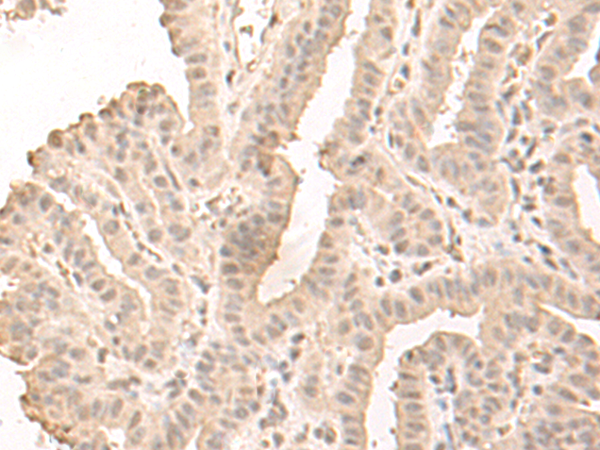
| WB | 咨询技术 | Human,Mouse,Rat |
| IF | 咨询技术 | Human,Mouse,Rat |
| IHC | 1/50-1/300 | Human,Mouse,Rat |
| ICC | 技术咨询 | Human,Mouse,Rat |
| FCM | 咨询技术 | Human,Mouse,Rat |
| Elisa | 1/5000-1/10000 | Human,Mouse,Rat |
| Host/Isotype | Rabbit IgG |
| Antibody Type | Primary antibody |
| Storage | Store at 4°C short term. Aliquot and store at -20°C long term. Avoid freeze/thaw cycles. |
| Species Reactivity | Human, Mouse |
| Immunogen | Fusion protein of human SAP130 |
| Formulation | Purified antibody in PBS with 0.05% sodium azide and 50% glycerol. |
+ +
以下是关于SAP130抗体的3篇参考文献及其摘要概括:
---
1. **文献名称**: *SAP130 regulates an invariant chromatin signature in B-cell lymphoma via interactions with SIN3A*
**作者**: Fleischer TC, et al.
**摘要**: 研究揭示了SAP130作为SIN3A转录调控复合体的核心组分,在维持B细胞淋巴瘤表观遗传特征中的作用。通过抗体阻断实验,发现SAP130缺失导致组蛋白去乙酰化酶活性降低,进而影响癌基因表达。
---
2. **文献名称**: *SAP130 promotes ASC pyroptosis by linking caspase-1 with NLRP3 inflammasome activation*
**作者**: He Y, et al.
**摘要**: 该文报道SAP130通过结合NLRP3炎症小体中的ASC蛋白,促进caspase-1依赖的细胞焦亡。研究使用特异性抗体证实SAP130在巨噬细胞炎症反应中的关键调控作用,为靶向炎症疾病提供新思路。
---
3. **文献名称**: *The DNA damage-inducible RNA-binding protein SAP130 is a novel therapeutic target in acute myeloid leukemia*
**作者**: Nomura S, et al.
**摘要**: 研究发现SAP130在急性髓系白血病(AML)中异常高表达,通过抗体介导的功能抑制实验证实其通过调控DNA损伤应答通路促进白血病细胞存活,提示其作为AML潜在治疗靶点。
---
以上文献均涉及SAP130抗体在机制研究或疾病治疗中的应用,涵盖肿瘤生物学和免疫学领域。
The SAP130 antibody targets the Sin3A-associated protein 130 (SAP130), a core component of the SIN3 transcription regulatory complex. This evolutionarily conserved complex plays a critical role in chromatin remodeling and epigenetic regulation by recruiting histone deacetylases (HDACs) to modify gene expression. SAP130. with a molecular weight of ~130 kDa, directly interacts with SIN3A and HDAC1/2. serving as a scaffold to stabilize the complex and mediate its binding to specific genomic loci.
Functionally, SAP130 is implicated in transcriptional repression, DNA repair, and cell cycle regulation. Studies suggest its involvement in both canonical HDAC-dependent gene silencing and non-canonical roles, such as modulating pre-mRNA splicing. Dysregulation of SAP130 has been linked to cancers, neurodegenerative disorders, and immune responses, where aberrant expression correlates with disease progression.
The SAP130 antibody is widely used in techniques like Western blotting, immunoprecipitation, and immunofluorescence to investigate its localization, protein interactions, and expression patterns. Validated antibodies typically show specificity through knockout controls or siRNA knockdown. Commercial sources often provide data confirming its reactivity across human, mouse, and rat samples. Researchers utilize this tool to explore SAP130's dual roles in transcriptional regulation and potential as a therapeutic target, particularly in contexts involving chromatin remodeling defects or spliceosome dysfunction.
×